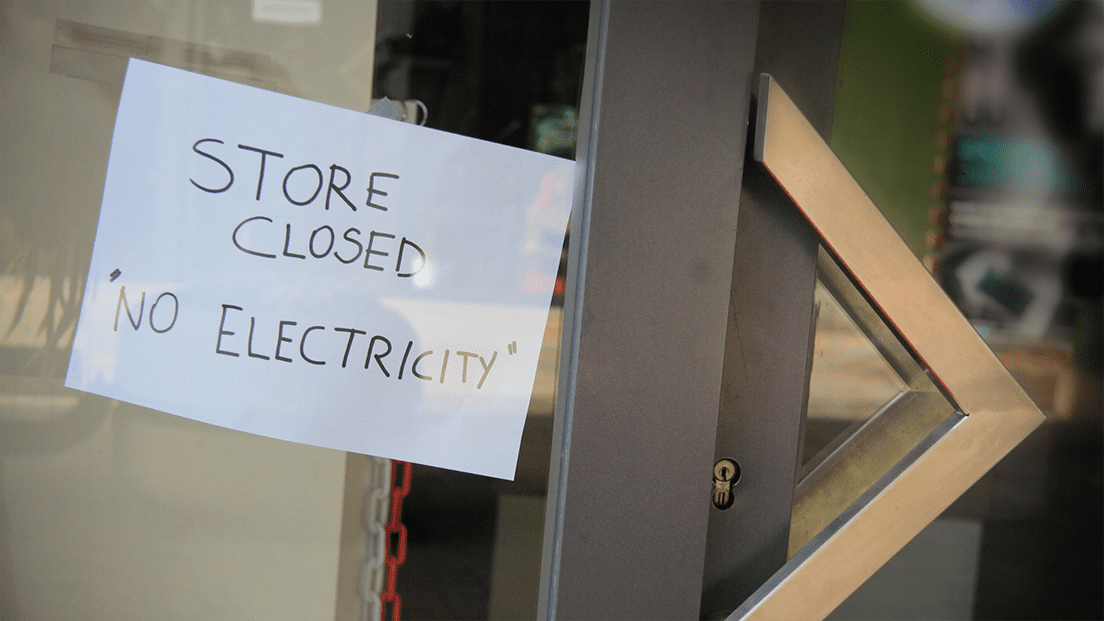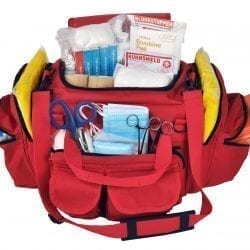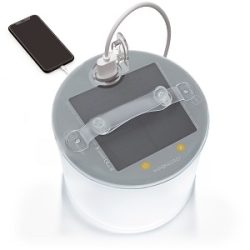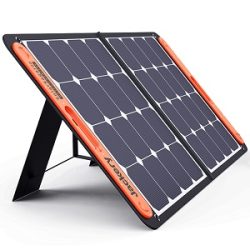Americans average around 1.42 power outages per year, each lasting an average duration of 7 hours. As power outages become increasingly common, their impacts on businesses are damaging. Each year, they cost the U.S. economy a staggering $150 billion
This comprehensive guide helps you stay ahead of unexpected power disruptions. Our goal is not just to meet the basic needs of your employees but to empower your business to thrive and function during a blackout. Imagine the peace of mind knowing that your business, employees, and customers are protected with a well-prepared plan.
Discover how easy it is to create a custom emergency kit tailored to your unique needs, and equip your business today to face tomorrow’s challenges confidently.
Understanding Power Outages
There are three types of power outages: brownouts, blackouts, and permanent faults.
Brownouts are reductions in power supply, blackouts are complete power losses, and permanent faults are the sudden loss of power typically caused by a power line fault.
Several factors contribute to power outages, including severe weather conditions like thunderstorms, hurricanes, and blizzards that damage power lines and equipment.
Natural disasters such as tornadoes and hurricanes lead to power outages, with snow also posing a risk by weighing down power lines. States with heightened wildfire risks may experience scheduled blackouts to prevent damage to the power grid.
Power outages affect California, Texas, and Florida more than any other area in the country.
Over the past two decades, Florida has seen the highest number of power outages affecting energy customers, with over 900,000 people impacted.
However, in 2022, Texas reported the highest number of impacted customers, partly due to the failure of the state’s power grid in 2021.
Almost a quarter of all power outages in the United States occurred in California in 2022, primarily due to increasing temperatures, droughts, wildfires, and strained power grids.
From 2000 to 2022, Texas experienced the most power outage events, affecting at least 50,000 customers, followed by California and Michigan.
These statistics highlight the varying degrees of electrical grid stability across different states and underscore the importance of being prepared for power outages, especially in areas with higher incidences.
The duration of these outages also varies significantly from state to state.
For instance, Maine experienced the highest average number of outages per year and had significant average annual downtime, only slightly less than Florida.
Given this variability in the frequency and duration of power outages across states, it’s essential for businesses, particularly in these high-risk areas, to have robust preparedness plans, including comprehensive emergency kits and backup power solutions.
Building an Effective Emergency Kit for Your Business
A well-prepared emergency kit is your first line of defense in a power outage. You must ensure that your business continues functioning at some level and supports your employees and customers.
Everything in your emergency kit should be easily accessible, and everyone in the building should know its location.
Depending on the size and nature of your business, different departments may have unique needs.
For instance, the IT department might require specific tools and equipment for data protection, while the customer service department might need additional communication devices to the outside world.
Seasonal Considerations in Kit Preparation
The contents of your emergency kit may need to vary with the seasons.
The additional heating solutions needed in the winter aren’t necessary when the temperatures rise. But once the air conditioning shuts off in the summer, your emergency kit should contain extra water and other cooling methods.
Everything You Need in your Power Outage Emergency Kit
Basic Supplies
Flashlights and Batteries – High-quality flashlights and ample batteries are essential for visibility and safety. While not a part of your kit, double-check your emergency lighting. This includes battery-operated lights and signage to guide people to safety in case of a power outage.
First Aid Kit – Comprehensive first aid supplies that address minor injuries and medical needs during an outage. These include bandages, alcohol wipes, and utility shears.
Water and Non-Perishable Food – A stock of emergency water pouches and non-perishable food items is crucial to sustain employees and customers during prolonged outages.
If you’re in the food service industry, maintaining the safety of perishable goods should be one of your top priorities. Plan to keep refrigerators and freezers closed and know how to check food for spoilage post-outage.
Portable Radios – Keep informed during a blackout with battery-powered or hand-crank radios.
Safety and Comfort Items
Blankets or Warm Clothing – Emergency thermal blankets keep your employees safe and warm during outages in colder seasons.
Safety Gloves and Goggles – Protect employees when handling debris or during cleanup.
Communication Tools
Emergency Contact List – Include contacts for emergency services, utility companies, and key personnel.
Backup Chargers: To maintain communication, use battery packs or solar chargers for mobile phones and laptops.
Specialized Equipment
Surge Protectors – These devices protect sensitive electronics from power surges when electricity is restored.
Backup Power Sources – Portable generators keep critical systems operational. Use generators in well-ventilated areas outside.
Regular Review and Updating of Your Plan
Your power outage emergency plan should be a living document, regularly reviewed and updated as your business evolves. Some preparation includes testing batteries, checking the expiration dates on food and medical supplies, and keeping all equipment in working order.
Training Employees on Emergency Procedures
It’s essential to conduct regular training sessions for your employees on how to use the emergency kit and what to do during a power outage. This training should cover evacuation procedures, equipment shutdown processes, and first aid basics.
Communication During an Outage
Effective communication is critical during a power outage. Have a plan to communicate with employees, customers, and emergency services, including having a battery-operated PA system or walkie-talkies available during a power outage.
Data Protection and Backup
For businesses reliant on digital data, having robust data protection and backup solutions is essential. Look into off-site backups or cloud storage solutions to protect against data loss during power outages.
This is usually the result of power surges damaging equipment, like when you lose data on a USB drive for pulling it out too quickly.
Identify your most important data devices and invest in backup power solutions like generators or uninterruptible power supply (UPS) systems.
These systems can keep critical systems running and prevent data loss during short-term outages.
If you’ve experienced more prolonged power outages, consider larger generators or alternative energy sources like solar panels.
Electronics and machinery are vulnerable to power surges when the power returns. Using surge protectors and instructing employees to shut down safely and disconnect equipment saves your business from costly damages.
Handling Financial Transactions
If you’re in a storefront, electronic payment systems may fail when the power goes out. Have a plan for handling financial transactions manually, if necessary, and take the time to train employees on how to handle these interactions.
Community Resources and Support
Be aware of local community resources and support systems that assist during extended power outages. Here are some resources to have on hand:

Local Government and Emergency Services Websites
If your power is out, that doesn’t mean your cell phone has lost service. Local government websites often have dedicated sections for emergency services, including updates on power outages, road closures, and safety tips.
They may also provide links to local shelters or cooling and heating centers, which is especially useful during extreme weather conditions.
FEMA Mobile App
The FEMA app provides timely alerts, safety tips, and shelter information. It’s a handy tool for both preparation and response phases of power outages and other emergencies.
Utility Companies
Utility companies’ websites and social media platforms are primary sources for real-time updates on power outages.
Many utility companies offer outage maps, restoration time estimates, and safety information. They also provide guidelines on reporting outages and downed power lines.
Community-Based Organizations
Local non-profits and community organizations often provide direct assistance during power outages, such as distributing supplies or offering temporary shelter.
Social Media and Community Forums
Platforms like Nextdoor, Facebook Groups, or local forums can be useful for community-level information sharing. Residents often post real-time updates, advice, and offers to help neighbors during power outages.
NOAA Weather Radio
NOAA Weather Radio provides continuous weather information, which can be crucial during severe weather-related power outages.
Although not a traditional online resource, it’s a vital tool for receiving alerts and updates.
Post-Outage Recovery
Once the power is restored, plan to restart electronic equipment and machinery safely. Check all systems for functionality and address any issues that may have arisen during the outage.
Also, check on each of your employees and allow them to reach out to loved ones nearby.
LifeSecure has Everything You Need for Your Power Outage Emergency Kit
Don’t wait for the next blackout to realize the importance of being prepared. Whether you’re looking for emergency blankets or comprehensive first-aid kits, LifeSecure has everything you need.
Our hand-picked products offer peace of mind, ensuring that your business, employees, and customers are well-protected during a power outage.













